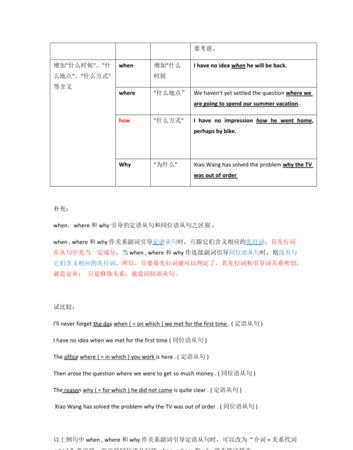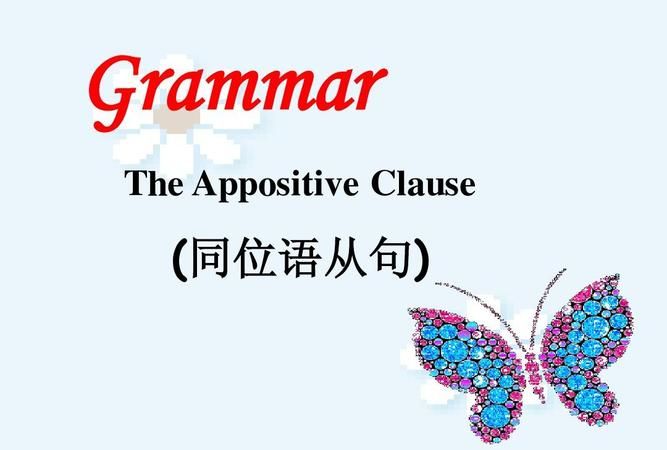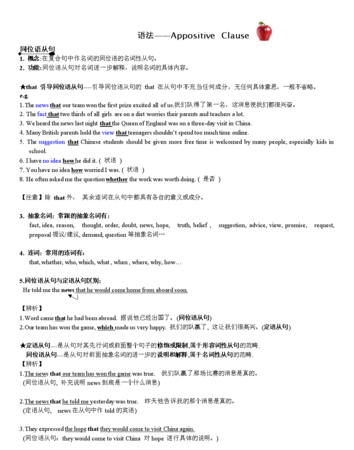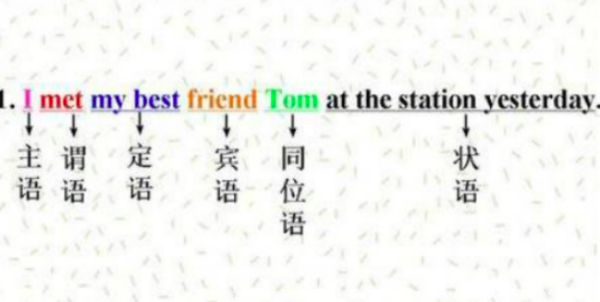本文目录
同位语是什么可以举几个例子
“同位语”是用来进一步说明前面某一个名词的词.例如:
Mrs.Brown,John's mother is a kind lady.约翰的妈妈,布朗太太是一个和蔼的女士.
说明:这里的John's mother就是“同位语”,用来进一步说明Mrs.Brown的身份.
除了“名词”作同位语,还有用一个句子作同位语,我们叫它“同位语从句”.例如:
Word came that her husband was killed in an accident.有消息传来她丈夫在事故中丧生了.
说明:这里的同位语为her husband was killed in an accident,目的是用来进一步说明word,即“消息”的具体内容.
如需要,我还可以给你更多的例句.

英语中的“同位语”是什么请举例说明.
楼上的句子到处都是语法错误.要改你的句子都要写一大篇了.干脆只告诉你正确的句子吧:
It was Lily who came up with the idea that people should drink more soft drink.
这里,idea和that people should drink more soft drink是等同的,所以that people should drink more soft drink是个同位语从句.注意idea不是楼上所说的主语.这句话的主语是It.
略微把上句改一下,就可以造出一个主语的同位语来:
Lily, the girl who came up with the idea that people should drink more soft drink, is in my class.
这样,the girl就是Lily的同位语.后面的who came up with the idea是定语从句.而that people should drink more soft drink仍然是idea的同位语.
记住同位语和它所修饰的词是完全等价的.再给你一些例子:
My sister Helen will come with us.
Helen是同位语,修饰my sister.
The news that he died shocked everyone.
that he died是同位语从句,修饰the news.

英语中的“同位语”是什么
楼上的句子到处都是语法错误。要改你的句子都要写一大篇了。干脆只告诉你正确的句子吧:
It was Lily who came up with the idea that people should drink more soft drink.
这里,idea和that people should drink more soft drink是等同的,所以that people should drink more soft drink是个同位语从句。注意idea不是楼上所说的主语。这句话的主语是It。
略微把上句改一下,就可以造出一个主语的同位语来:
Lily, the girl who came up with the idea that people should drink more soft drink, is in my class.
这样,the girl就是Lily的同位语。后面的who came up with the idea是定语从句。而that people should drink more soft drink仍然是idea的同位语。
记住同位语和它所修饰的词是完全等价的。再给你一些例子:
My sister Helen will come with us.
Helen是同位语,修饰my sister。
The news that he died shocked everyone.
that he died是同位语从句,修饰the news.

英语中什么是同位语
一个名词(或其它形式)对另一个名词或代词进行解释或补充说明,这个名词(或其它形式)就是同位语。同位语与被它限定的词的格式要一致,并常常紧挨在一起。同位语除表示其同位成分的全部意义外,还可以表示部分意义。

扩展资料:
of引导的同位语:
1、限定词the + 名词 + of + 名词。此时,of是同位语的引导词,本身没有意义。of后面的名词是其前名词的同位语。如:
The city of Newcastle lies at the mouth of Newcastle river.
纽卡斯尔城纽卡斯尔位于纽卡斯尔河口。
2、不定冠词a(an) + 表示面积、长(宽、高、温、……)度、比例的名词+of+数字。of后面的词是其前名词的同位语。如:
Belgium has an area of 11,778 square miles.
比利时面积有一万一千七百七十八平方英里。
3、限定词the、this、that、等 + 名词 + of + 名词性物主代词或不带中心词的名词所有格。此处,of前的名词由于受限定词the、this、that等的限定,它和of后面的名词性物主代词或不带中心词的名词所有格(作名词用)同指一个事物。of后的名词性物主代词或不带中心词的名词所有格是of前的名词的同位语。如:
What do you think of this sonata of Beethoven' s?
你觉得贝多芬的这首奏鸣曲怎么样?
4、限定词the、all等 + 数词 + of + 宾格代词或名词。both虽然是限定词,但它又含有数的意味,因此of前也可单用both.如:
I'll take both of them.
我要把他们两个都带上。
5、purpose,hope,question等 + of + 动名词短语。这时,of后面的动名词短语相当于同位语从句。如:
Is there any hope ofXiao Wang winning the Championship?
小王有没有获冠军的希望?
6、名词problem,question等 + of + 疑问句 + 动词不定式。如:
The question of when to leave never came up.
从没提起过何时离开的问题。
以上就是关于英语同位语举例说明,什么是同位语举例子说明一下的全部内容,以及英语同位语举例说明 的相关内容,希望能够帮到您。

